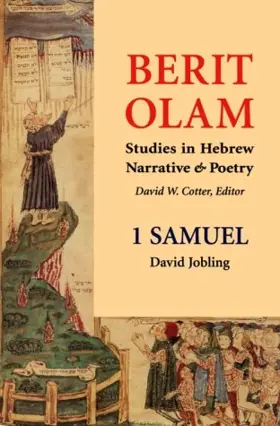

1 Samuel
in Berit Olam: Studies in Hebrew Narrative and Poetry
Pages
330 pages
Publisher
Liturgical Press
Published
10/1/1998
ISBN-13
9780814650479
1 Samuel is a national autobiography of the Hebrew people. David Jobling reads 1 Samuel as a story that is complete in itself, although it is part of a much larger narrative. He examines it as a historical document in a double sense: (1) as a document originating from ancient Israel and (2) as a telling of the past. Organizing the text through the three interlocking themes of class, race, and gender, Jobling asks how this historical—and canonical—story relates to a modern world in which these themes continue to be of crucial importance.
While drawing on the resources of biblical "narratology," Jobling deviates from mainstream methodology. He adopts a "critical narratology" informed by such cultural practices as feminism and psychoanalysis. He follows a structuralist tradition which finds meaning more in the text's large-scale mythic patterns than in close reading of particular passages, and seeks methods specific to 1 Samuel rather than ones applicable to biblical narrative in general.
While drawing on the resources of biblical "narratology," Jobling deviates from mainstream methodology. He adopts a "critical narratology" informed by such cultural practices as feminism and psychoanalysis. He follows a structuralist tradition which finds meaning more in the text's large-scale mythic patterns than in close reading of particular passages, and seeks methods specific to 1 Samuel rather than ones applicable to biblical narrative in general.
Reviews
Tackles more theological issues. I did not find this that helpful. Probably just for a specialist in hermeneutical and interpretive issues in Samuel than a commentary
This commentary is lucky to even get one star. If I could give no stars I would. It is completely liberal and way out there!
David Jobling's Berit Olam (1998) on I Samuel is strong on literary and structural issues, from a very critical perspective that is explicitly and deliberately feminist and postmodernist. If you care about structuralist and Marxist readings of Samuel or interpretations focusing on the Philistines as "the other", you'll enjoy this, but if you're interested in understanding the text this wouldn't be my recommendation. Some conservative reviewers nonetheless find valuable insights in this commentary, but he stands far apart from any attempt to reconstruct authorial intent or to discover what message the text offers to us apart from whatever concerns we might want to derive from it. In some ways this isn't exactly a commentary on the text if that means that it moves through the text in order to discuss it. It reads more like a series of essays that are arranged in a more generally chronological order.
[Full Review]
Feminist and deconstructionist essays on the book's structure and message from a modern critical perspective.
[Full Review]
This volume is the first English-language study of 1 Samuel as a whole to appear after a five-year lull that followed publication of the concluding volume of Jan Fokkelman's monumental monograph (Narrative Art and Poetry in the Books of Samuel: A Full Interpretation Based on Stylistic and Structural Analyses [4 vols.; Assen: Van Gorcum, 1981-93]). Whether by accident or not, the interpretive modes employed by Fokkelman and Jobling are widely divergent and in many respects antagonistic. While Fokkelman digs deep into the text, Jobling prefers to hover over it, in the sphere of contexts and intertexts. Fokkelman's project rests upon the premise that 1 Samuel can and must be dispassionately studied by objective scientific methods; Jobling is deliberately, if not provocatively, passionate, subjective, and partial. Fokkelman is interested mainly in the author's presuppositions and intentions implicitly operative in the book; Jobling's primary concern is his own interaction with it. Since both Fokkelman and Jobling eschew all kinds of diachronic analysis, differences between them reflect a deep rift within literary-critical, synchronic-minded biblical scholarship. This rift separates the scholars who believe that their task is to figure out what the Hebrew Bible is trying to tell us (text-oriented strategy) from those whose principal objective is to meet certain social, political, cultural, or ideological needs of the late twentieth-century readership (reader-oriented strategy). The reviewed book, repeatedly raising the issues of method and on several occasions (pp. 25-26, 143-44, 288-96) attacking the text-oriented "orthodoxy," represented by Robert Alter, Frank Kermode, Robert Polzin, and Lyle Eslinger, is in fact a large-scale affirmation of the latter approach.
[Full Review]
In this contribution to a fascinating commentary series, Jobling examines 1 Samuel according to T. Eagleton's triptych of class, race, and gender. It explores the tension between 1 Samuel as a book in itself and as a part of a larger whole. Jobling's approach to 1 Samuel as Israel's national autobiography is a summation of the course of his own academic career. The 1970s saw him engage structuralism and feminism, while poststructuralism and ideological criticism marked his career in the 1980s. In the 1990s, he turned to new historicism and psychoanalysis. All of these methods come together in an analysis that affords Jobling personal reflection on his own career in a seminary with a high percentage of female students. Jobling denies that ideological criticism can be divorced from the fight for equality for the disempowered. He complains of the "travesty" and "narrowtology" of the new literary "orthodoxy," naming specifically R. Alter, F. Kermode, M. Sternberg, L. Eslinger and especially R. Polzin (e.g., pp. 25, 144, 166-169, 308-309). Jobling replaces these scholars' concern for identifying literary artistry and narratorial omniscience in 1 Samuel with a program of uncovering points at which the text reveals uncertainty over the meaning of the past, and of recovering incompletely suppressed expressions of Israel's premonarchic egalitarian ideals. In chapter 2 Jobling divides 1 Samuel according to book divisions presumably original to the DtrH (following M. Noth and D. J.
[Full Review]



